In our series of Best CPU guides, here’s the latest update to our recommended workstation CPUs list. All numbers in the text are updated to reflect pricing at the time of writing. Numbers in graphs reflect MSRP.
Best CPUs for Workstations May 2020
Sometimes choosing a CPU is hard. So we've got you covered. In our CPU Guides, we give you our pick of some of the best processors available, supplying data from our reviews. Our Best CPUs for Workstations guide mostly covers workstation processors available to consumers, although some server products cover both segments.
| Workstation CPU Recommendations: 2020 May (Prices are 28-Dec or MSRP) |
||||
| Segment | Processor | |||
| Most Cores | Non-ECC: Threadripper 3990X ECC: EPYC 7702P |
$3700 $4783 |
||
| The Smart Money | Threadripper 3970X | $1900 | ||
| HEDT Mid Range | Threadripper 3960X | $1400 | ||
| AVX Accelerated | I'd Suggest Intel, But... | |||
| Memory Support | EPYC 7302P (2 TB/skt) Intel Cascade Lake (2 TB/skt?) Intel Xeon + Optane (4.5 TB/skt) |
$914 $700 $arm+$leg |
||
| HEDT On a Budget | Threadripper 1920X | $200 | ||
As we move through 2020, there comes a time when the high-end desktop market slows down a bit and everyone can sit on some new hardware for a while, knowing that they have the best for their money. With the release of AMD’s Third Generation Threadripper processors and Intel’s Cascade Lake-X hardware, we are now in that quiet period and we can give some recommendations.
It is worth noting that for some high-end desktop users, particularly professionals that can amortize the cost of the hardware over time due to their increased throughput, price and longevity might not be an issue. Also, businesses or even academic institutions may have preferred vendors for their pre-built systems, and as a result will experience a different cost structure than just simply buying a processor – they end up with a system that might have an extended parts and support warranty, or even with progressive automatic upgrades, and it will be up to the vendor to supply that. Hopefully this list can be useful to those vendors as well when it comes to building systems for their customers.
An ECC Question
Also, to address the issue of ECC on AMD's Ryzen and Threadripper platforms. ECC lies in this region of 'it kind of works' but isn't validated. There is what's called 'unofficial support', which is different to 'official qualification'. Technically, none of the Ryzen and Threadripper CPUs are 'officially qualified' for ECC, however most of them (if not all) will exhibit unofficial support. This means that it might work, but AMD won't give you assistance for it. There are two caveats to this:
First, it requires motherboard support. Some vendors are designing their boards with ECC support, and some will formally qualify supporting ECC. Note that even if the vendor lists official support, you are in 'unofficial support' from AMD's perspective.
Secondly, there's the 'is it working' question. Sure you can have a CPU that unofficially supports ECC, and ECC memory in a motherboard that 'officially supports' ECC, and there are tools in the OS to determine that all the parts of the chain support it. But the next question is if it actually works - some software only checks the 'does it support ECC' flag, rather than actually testing for it. There are reports of users who, by most measures, have everything in the chain sorted and reported as working, but none of it is actually enabled. This could be down to specific drivers, or a BIOS issue. Some software might say 'ECC found, running, but not enabled', or words to that effect. Ultimately you need the ability to support ECC tracking, which often isn't supported natively on consumer grade motherboards. On server grade motherboards, it is.
It's a minefield, and your mileage may vary. Our recommendation here is that if you absolutely need an AMD CPU with ECC as a mission critical part of your build, go for EPYC.
We Would Suggest Intel, But We Can’t Find Many
So straight off the bat, there’s going to be an outcry that I’m not recommending any Intel CPUs here. Intel recently launched its Cascade Lake-X Refresh platform in November with significantly lower prices than the previous Skylake Refresh-X generation, so why is this a problem? It comes in several stages.
Firstly, Intel’s recent production demand continues to outstrip supply. As a result, the company is focusing on manufacturing mostly its high performance hardware, mostly in its Xeon line. Intel has previously made a commitment to still keeping the market with Core i9 and Core i7 hardware, so the fact that we can’t find any HEDT processors to buy at the major etailers in the US is quite a concern. The consumer 9900K processors do seem to be in good supply by comparison.
Also, major etailers in the US have even gone so far as to remove Intel product pages from their website completely, due to both the lack of stock and the lack of a commitment to obtaining new stock. This is despite Intel’s CEO Bob Swan even writing about maintaining production and supporting its customers in an open letter entitled ‘We Are Here For You’. Searching for the top-end Cascade Lake-X Corei9-10980XE on Amazon shows no listing, and only the second item actually gives a relevant CPU that isn’t in stock. There is some stock at third parties, such as on Newegg with the lowest core count model, but out of stock. B&H has listings for all CPUs, but zero stock or back-order for all of them.
Intel has stated that through 2020 there will still be supply issues for its processors. Given that the HEDT market is a thin slice of the company’s total throughput, it means that this market might be low priority for production right now. Also, given that Intel has recently reduced the scope of its Cooper Lake Xeon platform, at this point we don’t know what’s in store for Intel’s HEDT platform in the future. The company has just announced its Comet Lake processors, but this is only up to 10 cores for a dual channel design on the consumer platform.
Going for the Most Cores:
AMD Threadripper 3990X at $3700
(or AMD EPYC 7702P at $4784 for ECC)
Sometimes all you want are cores - either for masses of virtual machines, or highly parallel workloads, or something else. Both AMD and Intel try to keep their highest core count hardware for their enterprise lines, such as 64-core EPYCs and 28/56-core Xeons, which means that these also come at an additional cost for features such as multi-socket capabilities or RDIMM support and RAS features.
For more ‘consumer’ hardware, the highest core count on offer is 64 cores from AMD, with the Threadripper 3990X, currently available for $3700 from its MSRP of $3990. This chip gives 56 lanes of PCIe 4.0, with another 8 lanes for the chipset, and comes in at a base frequency of 2.9 GHz and turbo of 4.3 GHz. We tested the Threadripper 3990X against $20k of Intel’s premium enterprise CPUs, and for workloads that were embarrassingly parallel.
You can read our full review of the 3990X here:
The 64 Core Threadripper 3990X CPU Review
In The Midst Of Chaos, AMD Seeks Opportunity
If there is a need for ECC, users can get 64 cores in this way if they want to go EPYC. The single socket 64-core EPYC 7702P is the right choice here, with an MSRP of $4425, or a recent retail price of $4784. For that price the hardware has a base frequency of 2.0 GHz and a turbo frequency of 3.35 GHz, and access to eight full memory channels. The Threadripper 3990X has higher frequencies due to its higher TDP (200W vs. 280W), but as far the 3990X only has four memory channels. It will be important to keep this in mind.
If there is a need for ECC, users can get 64 cores in this way if they want to go EPYC. The single socket 64-core EPYC 7702P is the right choice here, with an MSRP of $4425, or a recent retail price of $4784. For that price the hardware has a base frequency of 2.0 GHz and a turbo frequency of 3.35 GHz, and access to eight full memory channels. The Threadripper 3990X has higher frequencies due to its higher TDP (200W vs. 280W), but as far the 3990X only has four memory channels. It will be important to keep this in mind.
Intel’s offerings go up to the 56-core Cascade Lake-AP processors, but these are only available as part of a default server system that Intel’s partners can sell on. Intel still refuses to attribute a price to this processor, although we’ve estimated it around $25000. There is the Xeon W-3175X up for sale, with 28-cores, for $3100, but this is almost the same cost for only half the cores. The EPYC 7702P in this instance, being a socketed part that can be purchased off the shelf, gets our vote.
The Smart Money:
AMD Threadripper 3970X ($1900)
One of the peak performers of the recent HEDT refreshes was the Threadripper 3970X. Offering 32 cores on a high-end desktop platform with a unified memory design at a price where Intel used to offer 10 cores not too long ago is an astonishing leap in cores per dollar, and when you factor in that the Threadripper has a higher IPC and an aggressive frequency makes it all the more impressive.
The main complaint with the previous generation 32-core 2nd gen Threadripper was the un-even memory distribution, and that is gone with the 3970X, allowing for a more unified design that does almost everything you want to do on a workstation really well.
In our 3970X review, I used the word ‘bloodbath’, because any benchmark where the Core i9-10980XE wanted to do well, the 3970X came and won, sometimes by a large margin by having nearly double the cores. The only multi-threaded test that the 10980XE won was AVX512 related, and some people complained that I didn’t point at the 35+ gaming tests where the 10980XE also won by small (sub-3%) margins, but those people clearly don’t know what these processors are about. The 3970X is a fine processor for anyone who can lay down $2000 for the chip and another $100+ for cooling (then $500+ for memory, $500 for motherboard, etc).
Mid-Range Offering:
AMD Threadripper 3960X ($1400)
(or Intel Core i9-10980XE, if you can find one)
For anyone wanting a more cost-effective high-end desktop system, then we can save some monies by looking at the mid-stack. This is where Intel is actually a bit more competitive: 18 cores in the i9-10980XE for an OEM price of $979 compared to the 24 core TR 3960X at $1399. Cost per core is obviously close, around $55/core for both, and both processors have plus points (although in our tests, the 24-core does pull ahead more often than not as is perhaps to be expected).
In previous guides this segment has always been varied due to availability. However while Intel still has issues, AMD’s options seem plentiful this time around. Some of these processors are ending up in the hands of system builders or OEMs (especially in Intel’s case), rather than going to retail.
One option here is to look at AMD’s Ryzen 9 3950X, although in the high-end desktop space this isn’t really suitable if you need lots of memory or lots of PCIe lanes. The Ryzen 9 3950X is also hard to find in certain regions.
There is an option of looking at older hardware. Finding a good deal on AMD’s 16-core 2nd generation Threadripper, the 2950X, is a good option, although given the performance of the 3rd generation hardware, I would perhaps avoid higher core counts unless it was really cheap. Intel is still selling the Skylake-X processors, and hopefully when this post goes live they will have half-price discounts applied, although that might not be a given.
If you really want the best mid-tier hardware, for AMD I’d suggest a cheap 2950X or wait until a 3960X is available.
AVX Accelerated:
I’d suggest Intel, But
I have added an AVX processor suggestion here for the simple fact that if a user is likely to encounter AVX acceleration, it’s going to be with software aimed at prosumers and high-end desktop users. Intel has been pushing its AVX512 support, even bringing it into its consumer laptop processors, in an effort to drive things like DLBoost to enhance AI throughput. One of the pain points I’ve had with Intel over the last couple of years is actually getting a list of AVX512 use cases: exact software examples where AVX512 is used. It often gets added for very specific things, like a certain filter in Photoshop, or a special edition of a benchmark, but ultimately those in the HPC space get the most from it. For those users, this suggestion is for you.
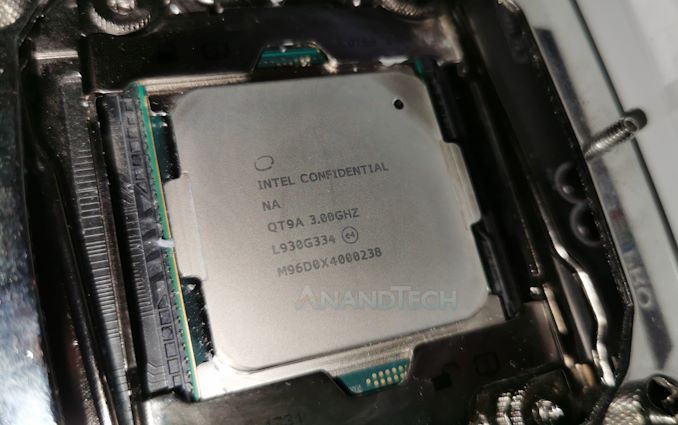
Our Core i9-10980XE review sample. It's a QS (Qualification Sample) chip,
which is meant to be as near as retail as possible.
The best high-end desktop off-the-shelf processor for AVX512 you can buy is the Core i9-10980XE, with 18-cores that all enable AVX512. If you need ECC, then the Xeon W-3275/3175X is going to be your best bet, but it will cost a bit more and a special Xeon W motherboard is needed. If cost is no object, then moving into a dual socket system with Xeon Scalable processors might be preferable, although take note that this introduces a non-uniform memory access (NUMA) environment, which would inhibit bulk data transfer if the software is not NUMA-aware. To be on the safe side usually single socket is preferred. The downside to going Intel here is finding a CPU for sale.
Memory Support:
AMD EPYC up to 2 TB per socket,
Intel Xeon with Optane DCPMM up to 4.5 TB per socket,
or Intel Core i9-10900X (or any Core i9-109xx series)
Some users are in it just for the memory support, either due to multiple VMs or high-memory use-case requirements. For these, sometimes the memory capacity is more important than the compute performance, as the software requires workspace in the terabytes – in this case doubling up to 128 GB of DRAM or more is always more beneficial than adding compute, as it reduces the pressure on moving data back and forth between DRAM and storage. Normally it is in this instance too that RDIMMs with ECC are recommended, just because as the memory capacity gets larger, the chance of an errant bit flip does scale with memory capacity. The price of the memory in this product category normally outweighs the CPU cost by an order of magnitude as well.
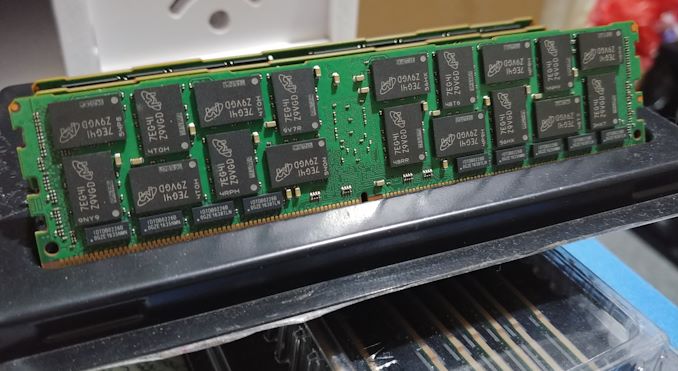
128 GB LRDIMM, original retail $4000+ (now $1200-ish)
In this instance, one choice is an EPYC, something like the 7232P at $500 will easily support 2 TB of LRDIMMs (mind you, if you’re buying *that* much memory, then going for the 64-core 7702P at $4784 isn’t that much of a leap) out of the box.
The only way to get more memory than this with an x86 processor would be to look to Intel Xeon Scalable processors equipped with Optane DC Persistent Memory, allowing up to 4.5 TB per socket. In order to get that amount, you have to invest in one of the M processors, which adds another $3k to the cost of the chip. The other factor here is that Optane DCPMM isn’t freely for sale through usual channels: it typically comes as part of an OEM system build, and as a result the user will end up with a support contact for a specific OEM. For bigger businesses and research communities, that should be suitable – check with your preferred OEM with what they have to offer.
I also want to put in a word here for Intel’s latest Cascade Lake-X processors. Normally, with four channels / eight memory slots and 32 GB of DRAM per slot, this would max out at 256 GB. But interestingly enough, when paired with an ASRock X299 motherboard (either the X299X Taichi, the X299 Steel Legend, or the X299 Creator), these motherboards can now support 128 GB RDIMMs, allowing for 1 TB of DRAM per single socket.
At this time ASRock is looking into also enabling LRDIMM support. This is a relatively new development, posted by one of ASRock’s engineers to his personal social media accounts, but the BIOSes required are now public, and for users invested in the Intel ecosystem this is well worth a look.
Cores for Cash:
AMD Threadripper 2950X ($400 on sale)
For anyone wanting the most cores for the least amount of $$$, then our pick has to go to the 16-core Threadripper 2950X or 1950X when these are on sale. With the launch of the new 3000 series Threadripper processors, the previous parts are often found at low prices with some retailers looking to empty their stock of them. We’ve seen 2950X processors as low as £330/$400 even on Amazon (currently $500), and 1950X for $250.
Having four channel memory and 64 PCIe lanes for prosumer workflows is great – as we noted in our reviews these processors cover most, but not all, the high-end desktop bases, so it is worth researching what works best for the intended software. But compared to several years old hardware, this is very much a worthy upgrade for a lot of people. The 2950X also performs better on a number of workloads compared to the 2970WX/2990WX, and can be found for a lot cheaper, making it a worthwhile purchase.
HEDT on a Budget:
AMD Threadripper 1900X
If you want a HEDT system on a budget, the question to ask is if it has to be new or used. In a lot of professional circumstances, new is still preferred, and the processor to get on the ladder here is AMD’s Threadripper 1900X. The 8-core processor offers high capacity memory support, lots of PCIe lanes, and the low-end motherboards for Threadripper are now entering that low-to-mid range pricing. In a sale, the 1900X can be found for under $200 (users with more money might look for a cheap 1950X instead), which seems like a crazy low price for a high-end desktop processor.
On The Horizon: Not A Lot
We’re at a time where the high-end desktop market is relatively stable. Both AMD and Intel have recently had big launches of the latest generation hardware, and we’re at least 2-3 quarters away from even speaking about the next generation parts, if not longer, and another 2 quarters away from launch. Any system purchased today will be set to last for a long time, and as a result, there isn’t much to look forward to for most of 2020.
For Intel, the situation is not clear in the slightest. We don’t know what Intel plans to launch in this space, or when. The company recently reduced the scope of its Cooper Lake Xeon platform to select customers only, which also puts a stop to any HEDT product. This means that the next generation Xeon coming to market should be Ice Lake on the company’s 10nm process. With an expected launch date of late 2020 for this, there are lots of concerned thoughts as to how many will actually be available – will Ice Lake Xeon be in general availability, what will the performance be like, and then for the HEDT market, when will it filter down? These are all questions I wonder if Intel can even hint at right now – for that manufacturing process, the key would be trying to manufacture the most cost effective parts that it can, and HEDT doesn’t hold a candle to the premium Xeon components. At this point in time, Intel’s HEDT future in 2020 looks dire, and we have no idea about 2021 or 10nm.
The highlight on this perspective is AMD’s Threadripper 3990X. The company launched a 64 core version of its Zen 2 high-end desktop family, which is one of the 64-core EPYC processors but with half the memory, half the PCIe, and a higher 280W TDP to drive the frequency higher. We're expecting Zen 3 products to start coming by the end of 2020, and although AMD has committed to both EPYC and Ryzen parts being available by the end of the year, we expect the HEDT market to be at the back end of that product rush, so we're looking into the middle of 2021 for a Threadripper refresh.
It seems then that any HEDT system purchased today isn't going to be obsolete for a long while yet.
Recent Threadripper / EPYC CPU Reviews (AMD)
- AMD Ryzen Threadripper 3990X (64 core)
- AMD Ryzen Threadripper 3970X (32 core)
- AMD Ryzen Threadripper 3960X (24 core)
- AMD Ryzen 9 3950X (16 core, consumer)
- AMD EPYC 7F52 (16 core, high frequency)
Recent HEDT / Xeon CPU Reviews (Intel)
- Intel Core i9-10980XE (18-core)
- Intel Core i9-9990XE (14 core, 5.0 GHz)
- Intel Core i9-9900KS (8 core, 5.0 GHz)
- Intel Xeon W-3175X (28 core unlocked)
Our benchmark database can be found at https://anandtech.com/bench
Benchmark Request
Moving into 2020, we're looking to update our benchmark suite for the next 12-18 months. Recently we've added an AI benchmark, more latency tests, instruction set testing, NAMD (limited to 64 threads right now), a heavy single threaded-limited simulation test, and Crysis rendered on the CPU. We're on the lookout for more workstation-focused tests, preferably with licence-free software for Windows that can be automated. If you have any ideas, please let us know. Or, if any ISV / software vendor is reading this, think the software is a good fit, and can arrange press licenses, please do get in touch.
from AnandTech https://ift.tt/2S6J7mK
via IFTTT
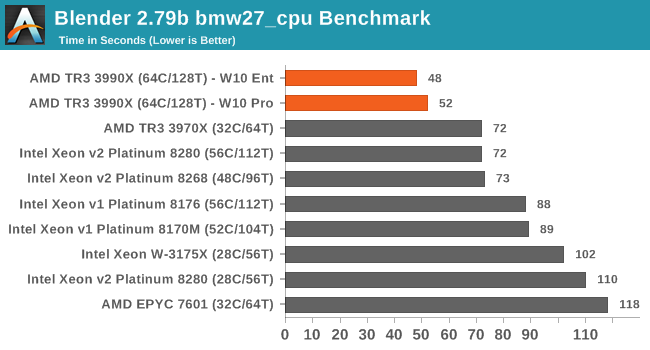
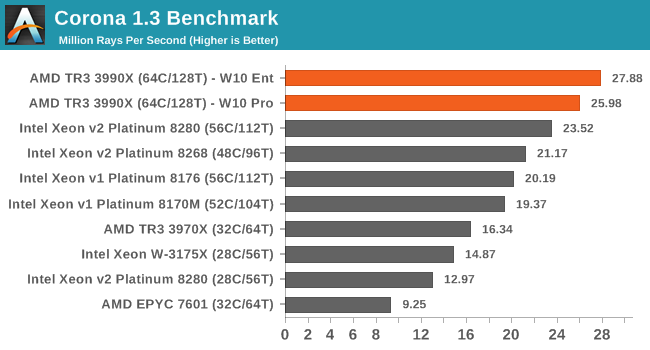
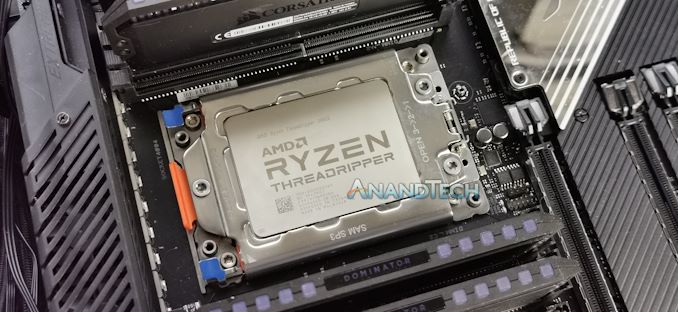
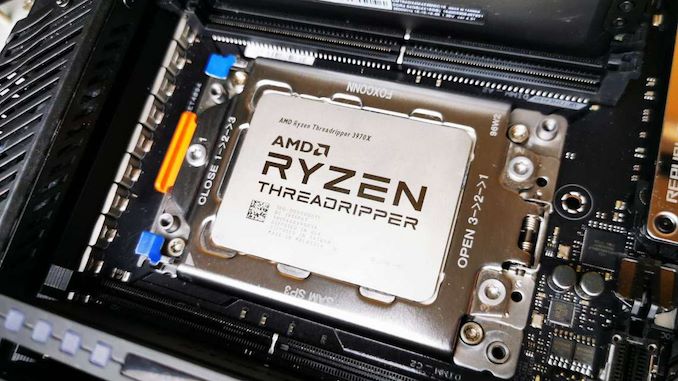
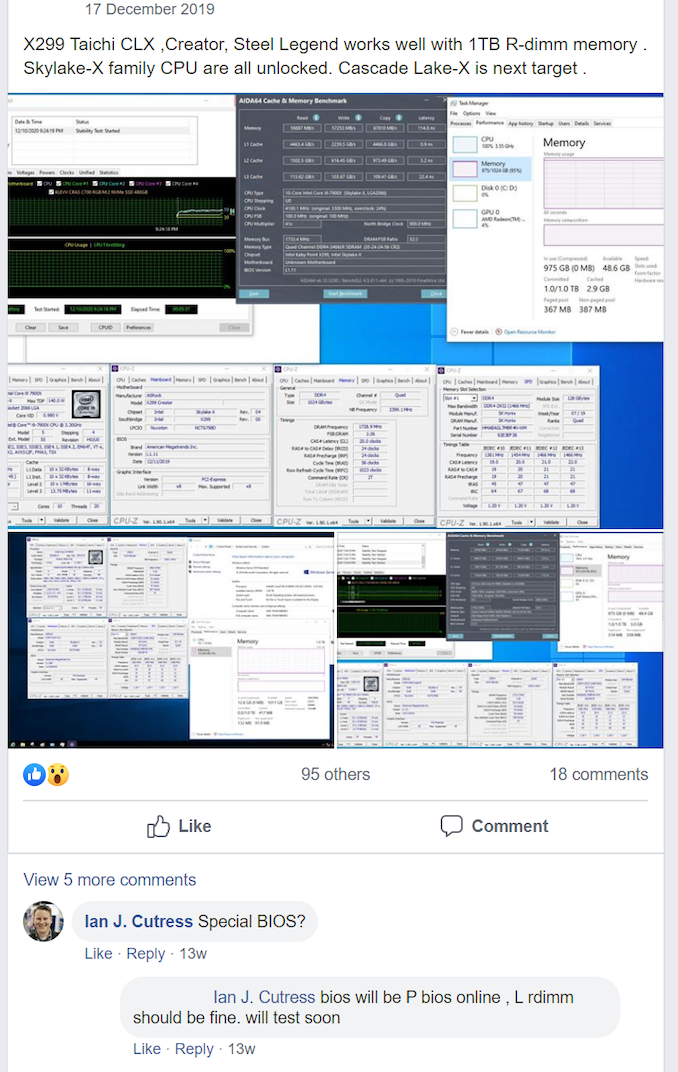
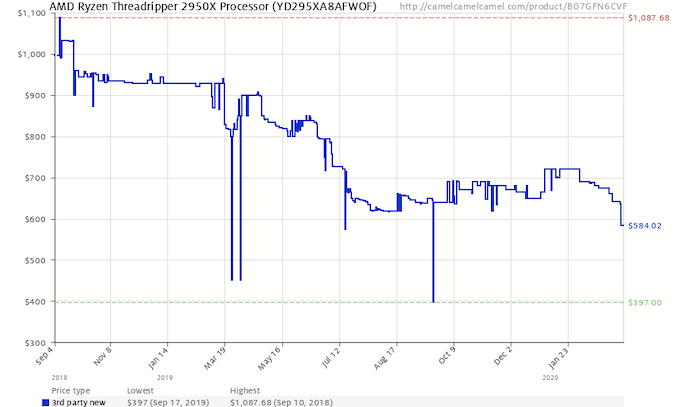

0 comments:
Post a Comment